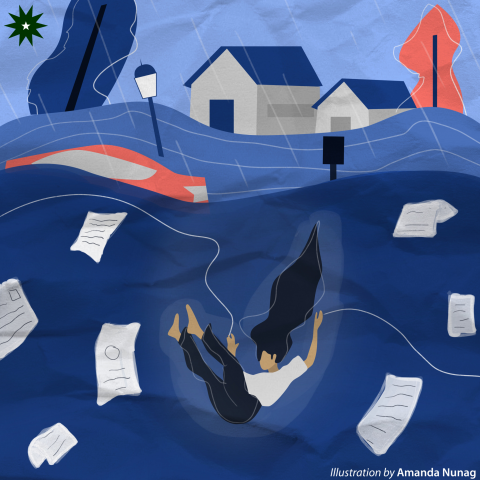
In the final quarter of 2020, the Philippines faced an onslaught of typhoons that struck different parts of the country, submerging countless homes and leaving many without proper water or electricity for days. In the past, this meant a cancellation of face-to-face classes, but given that classes have shifted online due to the pandemic, schools were faced with a new challenge. The DLSU administration had to rethink its approach and impose academic easing which later became a weeklong suspension. While these adjustments aimed to do good, the University’s response still received criticism from DLSU students on social media.
In an interview with The LaSallian, Vice Chancellor for Academics (VCA) Dr. Robert Roleda discusses the process of determining suspensions through coordinating with the University Student Government (USG) and clears issues surrounding petitions from One La Salle for Human Rights and Democracy, now known as La Salle Students for Human Rights and Democracy (LS4HRD).
A ‘lacking’ response
In response to the impact of Typhoon Ulysses, the University declared an academic ease last November 16 to 21, providing students a weeklong pause for pending requirements and graded activities while still allowing faculty to hold online synchronous sessions. Though this was meant to help severely affected students and faculty members cope with the sudden power outages and water interruptions that was dealt by the typhoons, some were still unsatisfied with this response.
Ralph Furigay (I, CS-NIS), who lives in Tuguegarao City, is among those who were hardest hit by the sudden floods and power outages from Typhoon Ulysses. He says that despite the good intentions behind the academic ease, he felt the guidelines were “lacking” because professors could still hold online classes if they wanted to.
“I felt pressured to divide my attention [between] school and the ongoing calamity,” he laments.
On November 15, LS4HRD released a petition that called for a two-week suspension of classes in all La Salle schools, reaching supposedly over 20,000 signatures in a day. The petition also drew support from various La Salle student groups, ranging from campus-accredited organizations to external youth alliances.
Roleda recalls that he had reservations on LS4HRD’s approach as “different parts of the country have different experiences,” citing that some students in basic education institutions tend to live near the school. For DLSU, however, the Academics Council relies on the number of students and faculty in affected areas.
Roleda also stresses that the differences in response between academic institutions are based on different conditions. “Ateneo de Manila University (ADMU) is next to Marikina…DLSU has only about 100 or so students who live in Marikina,” Roleda points out. “Our [academic] easing is actually more relaxed. In other aspects, of course, their (ADMU’s) suspension is more lax than ours.”
A day later, on November 16, the USG publicized their proposal to the administration that called for an academic break from November 16 to 28 in exchange for a two-week extension of the term, citing reports that recommended the entirety of Luzon be placed under state of calamity and data gathered by the School of Economics which showed that around nine percent of the student population were residing in areas gravely affected by Typhoon Ulysses.
“We listened to the students, particularly those living in areas that were flooded already. And what we saw was that, even though there was academic easing, there was this moral compulsion for the students to attend class,” explains USG President Lance Dela Cruz, who finds that LS4HRD’s petition is a “validation” of what the USG has been doing and played a role in formulating the body’s own proposal. The USG, however, was not a signatory to LS4HRD’s unity statement.
“After the announcement for suspension of classes, the USG reached out to members of the Lasallian community to have a dialogue with [LS4HRD] so that we can better work together in future initiatives,” he adds. “When students regardless of which part of the student body calls for it (academic break), we consider and we hear out their cases. We see the greater necessity for it when more students are calling for it.”
Taking into consideration
These efforts from the USG were soon recognized by the University as a one-week academic break was declared on November 17, followed by a week of academic easing from November 23 to 28. The academic calendar was adjusted soon after. But Roleda maintains that the petition had no influence on the administration’s decision to shift to an academic break.
“Our decision is based on information we gathered in terms of the number of students, faculty, and staff that reside in areas that were still flooded or [did] not have power on November 17,” he furthers.
Roleda admits, however, that they had not expected the immediate effects of the typhoon outside Metro Manila. Regarding heavily affected areas such as Cagayan, Isabela, and Pampanga, he says that administrators were “not yet aware” of the events in such places. “It’s only on that day itself that the flooding occurred in those places,” he remarks.
Following the drastic floods, the Academics Council took into account the percentage of those from the DLSU community in each area, concluding that around nine percent of students and more than 10 percent of the faculty were from the affected areas. Lengthy power interruptions in select areas, which prevent students from going online, had to be factored in as well.
“The situation is different now because in the past, the issue was about safety of students going to and from the University,” he highlights. “But now, the situation is many of our students are in the provinces; they’re not in Metro Manila anymore.”
Internet connectivity, too, became an added concern: last November 17, customers of internet service provider Converge ICT faced an abrupt network outage, an incident Roleda says that they are now taking into consideration. “Aside from typhoon signals, internet signals—WiFi signals [are] now the other thing that you have to look at, given the predominantly online learning that we’re doing,” he explains.
